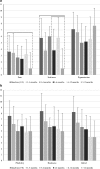A new treatment of hypertrophic and keloid scars with combined triamcinolone and verapamil: a retrospective study
- PMID: 29398785
- PMCID: PMC5780547
- DOI: 10.1007/s00238-017-1322-y
A new treatment of hypertrophic and keloid scars with combined triamcinolone and verapamil: a retrospective study
Abstract
Background: Since the management of keloid and hypertrophic scars still remains a difficult clinical problem, there is need for adequate, effective therapy. In this study, we explored for the first time the efficacy and the potential synergetic effect of combined triamcinolone and verapamil for the treatment of hypertrophic and keloid scars. The objective was to assess the efficacy of combined intralesional triamcinolone and verapamil therapy for hypertrophic and keloid scars.
Methods: Fifty-eight patients with hypertrophic scars (n = 31) and keloid scars (n = 27) were included. A specific injection therapy scheme was applied. Five follow-up moments were chosen, with a maximum follow-up of nearly 2 years. The effects of combination therapy on scar pliability, thickness, relief, vascularization, surface area, pain, and pruritus were examined by means of the Patient and Observer Scar Assessment Scale (POSAS).
Results: Our results reveal a fast and abiding improvement of both keloid and hypertrophic scars after treatment with the combination therapy. All POSAS components showed a reduction in scar score, while scar relief, pain, itchiness, and surface area improved significantly (P < 0.05) in keloids. Significant improvement in hypertrophic scars was found in scar pigmentation, vascularization, pliability, thickness, pain, and surface area. Overall POSAS scores revealed statistically significant decreases between baseline and 3-4 months, 4-6 months, and >12 months after start of therapy in both keloids and hypertrophic scars.
Conclusions: This study reveals that combined therapy of triamcinolone and verapamil results in overall significant scar improvement with a long-term stable result.Level of evidence: Level IV, therapeutic study.
Keywords: Hypertrophic scars; Keloids; Kenacort; Verapamil.
Conflict of interest statement
Compliance with ethical standardsAuthors Kant, van den Kerckhove, Colla, Tuinder, van der Hulst, and Piatkowski de Grzymala declare that they have no conflict of interest.For this kind of retrospective study formal consent from a local ethics committee is not requiredFor this type of study formal consent is not required.None.
Figures








References
-
- Fraccalvieri M, Bogetti P, Salomone M, Di Santo C, Ruka E, Bruschi S. Cryotreatment of keloids: a single Italian institution experience. Eur J Plast Surg. 2016;39:201–206. doi: 10.1007/s00238-015-1170-6. - DOI
LinkOut - more resources
Full Text Sources
Other Literature Sources
